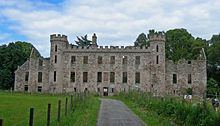 | ||
Fetternear Bishop's Palace is an archaeological site of what was one of the palaces (or residences) of the medieval bishops of Aberdeen. it is near Kemnay in Aberdeenshire. Later, a ruined towerhouse and mansion of Fetternear House were built on part of the site.
Contents
Fetternear parish and the location of the bishop’s Palace
The bishop’s palace at Fetternear was situated in what was, in medieval times, a separate parish. At the end of the sixteenth century the parish was incorporated, along with Logie Durno, into that of Chapel of Garioch. Fetternear’s parish kirk was dedicated to St Ninian and was on the north bank of the River Don about a mile from the bishop’s palace.
The palace itself is on sloping ground above the Marshes Burn near its confluence with the River Don opposite Kemnay. Placename scholars consider the Fetter- element of the name to be derived from the Gaelic term fetter (or fother, fodder, fether). Toponyms of this type typically refer to the situation of the place on shelving or terraced land. Scholars do not agree on the meaning of the –near element of the placename.
Scottish Episcopal Palaces Project – Fetternear
In an architectural history of the post-medieval mansion at Fetternear, H. Gordon Slade mentioned that very little of the bishop’s palace remained visible above ground. He thought that the "foundations or lower walls" were perhaps of a tower built in an "L" shaped plan. Slade’s article concentrates mainly on the post-Reformation architectural history of Fetternear House and its associations with the Leslies of Balquhain, the family who obtained the estate after the Reformation.
Given that very little scholarly attention had been given to the medieval bishop’s palace of Fetternear, the late Nicholas Bogdan, of the Scottish Castles Survey, and Penelope (Penny) Dransart, of the University of Wales, Lampeter, founded the Scottish Episcopal Palaces Project (SEPP) in 1995. The aim of the project is to investigate the architectural development of Scottish bishops’ palaces as residences that were designed to facilitate pastoral visitations throughout the diocese. To date the project has concentrated on the site of Fetternear in the medieval diocese of Aberdeen and on Kinneddar in the diocese of Moray.
The excavations at Fetternear done by SEPP have established that the visible remains of the foundations observed by Slade were heavily remodelled in the late nineteenth century, by one of the Leslie lairds of Balquhain and Fetternear. This remodelling was done after an excavation of those parts of the bishop’s palace that lay under the lawns in front of the mansion. William Kelly, the Aberdeen architect, reported having seen moulded stonework from the excavation in the first decade of the twentieth century, commenting on its fine quality.
The work of SEPP has demonstrated that the medieval bishop’s palace was largely surrounded by a moat. In all probability the earliest palace was constructed from timber on the platform enclosed by the moat, from which the water flowed through a ditch leading to the Marshes Burn. The 2006 excavation uncovered evidence for an oak palisade on the inside of the moat, surrounding the buildings of the palace. The entrance to the palace from the southeast would have been over a timber trestle bridge, the sole plate of which was excavated in 2009.
